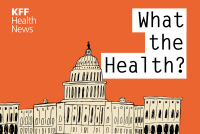Latest KFF Health News Stories
Scorpion Peppers Caused Him ‘Crippling’ Pain. Two Years Later, the ER Bill Stung Him Again.
Homemade hot sauce sent a Colorado man to the emergency room with what he called “the worst pain of my life.” But stomach cramps were only the beginning. Two years later, the bill came.
A casi dos semanas de iniciada la operación llamada Catahoula Crunch, que comenzó el 3 de diciembre, profesionales de salud y defensores comunitarios en Louisiana y Mississippi reportan un aumento inusual de pacientes inmigrantes que se han salteado citas médicas.
Call 911 or Risk Losing the Baby? Raids Force Some Immigrants To Avoid Care
More immigrants in New Orleans and Mississippi are skipping important health care appointments and experiencing heightened stress amid federal immigration raids.
Readers Make Their Wish Lists, Checking Up on Health Care
KFF Health News gives readers a chance to comment on a recent batch of stories.
Feds Promised ‘Radical Transparency’ but Are Withholding Rural Health Fund Applications
Proposals from states that have shared their applications to a new $50 billion rural health program include using drones to deliver medication, installing refrigerators to expand access to healthy produce, and bringing telehealth to libraries, day cares, and senior centers.
Gobierno prometió “transparencia radical”, pero oculta solicitudes de fondos para la salud rural
Drones que entregan medicamentos y telesalud en bibliotecas locales son algunas de las ideas que líderes estatales acaban de presentar para gastar su parte de un programa federal de salud rural de $50.000 millones.
Not Serious Enough To Turn on the Siren, Toddler’s 39-Mile Ambulance Ride Still Cost Over $9,000
After her son contracted a serious bacterial infection, an Ohio mother took the toddler to a nearby ER, and staffers there sent him to a children’s hospital in an ambulance. With no insurance, the family was hit with a $9,250 bill for the 40-minute ride.
Big Loopholes in Hospital Charity Care Programs Mean Patients Still Get Stuck With the Tab
Even if people qualify for financial help with their hospital bills, the care they receive may not be covered.
Experts Say Rural Emergency Rooms Are Increasingly Run Without Doctors
Some doctors and the groups that represent them say physicians’ extensive training leads to better emergency care, and that some hospitals are trying to save money by not hiring them. They support new laws in Indiana, Virginia, and South Carolina that require physicians to be on-site 24/7.
Readers Weigh In on Making American Health Care Affordable Again
KFF Health News gives readers a chance to comment on a recent batch of stories.
Surprise Medical Bills Were Supposed To Be a Thing of the Past. Surprise — They’re Not.
The No Surprises Act, which was signed in 2020 and took effect in 2022, was heralded as a landmark piece of legislation that would protect people who had health insurance from receiving surprise medical bills. And yet bills that take patients by surprise keep coming.
Insurers Fight State Laws Restricting Surprise Ambulance Bills
A Colorado bill banning surprise billing for ambulance rides passed unanimously in both legislative chambers, only to be met with a veto from the governor. As more states pass such legislation, some are hitting the same snag — concerns about raising premiums.
Aseguradoras rechazan leyes estatales que protegen contra facturas sorpresa por uso de ambulancias
Cuando una compañía de ambulancias cobra más de lo que una aseguradora está dispuesta a pagar, los pacientes pueden terminar con una factura enorme de la que no tienen escapatoria.
The House’s gigantic tax-and-spending budget reconciliation bill has landed with a thud in the Senate, where lawmakers are divided in their criticism over whether it increases the deficit too much or cuts Medicaid and the Affordable Care Act too deeply. Meanwhile, the Congressional Budget Office’s estimate that the bill, if enacted, could increase the ranks of the uninsured by nearly 11 million people over a decade won’t make it an easy sell. Alice Miranda Ollstein of Politico, Jessie Hellmann of CQ Roll Call, and Lauren Weber of The Washington Post join KFF Health News’ Julie Rovner to discuss these stories and more. Also this week, Rovner interviews KFF Health News’ Arielle Zionts, who reported and wrote the latest “Bill of the Month” feature, about a Medicaid patient who had an out-of-state emergency.
Fast Action From Bystanders Can Improve Cardiac Arrest Survival. Many Don’t Know What To Do.
In 9 of 10 cases, a person in cardiac arrest will die because help doesn’t arrive quickly enough. With CPR and, possibly, a shock from an automated external defibrillator, survival odds double. But Americans lack confidence and know-how to handle these interventions.
Según la Asociación Americana del Corazón, en Estados Unidos ocurren más de 350.000 paros cardíacos cada año fuera del ámbito hospitalario.
What the Health? From KFF Health News: The State of Federal Health Agencies Is Uncertain
The Supreme Court opined for the first time that Trump administration officials may be exceeding their authority to reshape the federal government by refusing to honor completed contracts, even as lower-court judges started blocking efforts to fire workers, freeze funding, and cancel ongoing contracts. Meanwhile, public health officials are alarmed at the Department of Health and Human Services’ public handling of Texas’ widening measles outbreak, particularly the secretary’s less-than-full endorsement of vaccines. Lauren Weber of The Washington Post, Joanne Kenen of the Johns Hopkins University School of Public Health and Politico Magazine, and Stephanie Armour of KFF Health News join KFF Health News’ Julie Rovner to discuss these stories and more.
A Runner Was Hit by a Car, Then by a Surprise Ambulance Bill
A San Francisco man had friends drive him to the hospital after he was hit by a car. Doctors checked him out, then sent him by ambulance to a trauma center — which released him with no further treatment. The ambulance bill? Almost $13,000.
Blood Transfusions at the Scene Save Lives. But Ambulances Are Rarely Equipped To Do Them.
More than 60,000 people bleed to death every year in the United States. Many of those deaths occur before the patient reaches a trauma center where blood transfusions can be given.
Readers Offer ‘Solo Agers’ Support and Reflect on Ancestors
KFF Health News gives readers a chance to comment on a recent batch of stories.



















